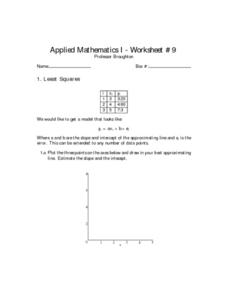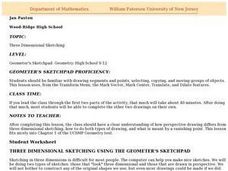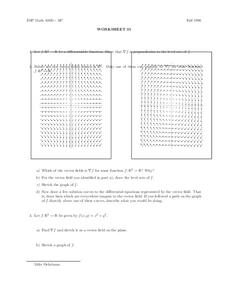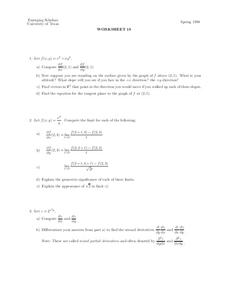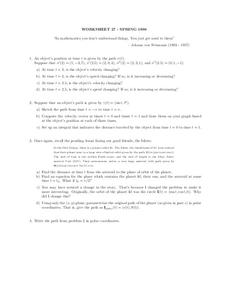Curated OER
Matrices and Vectors
In this matrices and vectors worksheet, students solve 9 various types of problems related to forming matrices and vectors. First, they set up each system of equations listed in matrix form using mathematical notation. Then, students...
Curated OER
Worksheet 24 Spring 1996
In this math worksheet, students find all the vectors in three dimensional space that have the length of 4. Also, the first and third components are the same. Finally, the second component is the sum of the first and third components.
Curated OER
Least Squares
In this least squares worksheet, students solve 6 different problems that include the least squares of numbers. First, they plot 3 points on the axes shown and draw in their best approximating line. Then, students estimate the slope and...
Curated OER
Vectors
In this geometry worksheet, students investigate vectors. They add, subtract and identify the magnitude of each vector. There are 4 questions with an answer key.
Curated OER
Three Dimensional Sketching
Pupils become familiar with drawing segments and points. They understand how perspective drawing differs from three dimensional sketching. They demonstrate three dimensional and perspective drawing.
Curated OER
Worksheet 21
In this math instructional activity, students draw two vectors u and v based at the same point. The vectors are considered neither parallel nor orthogonal.
Curated OER
Hang Time
Young scholars simulate the motion of a fly ball with different winds. They use a partner to provide the simulated wind. Students draw a baseball diamond and the field on a piece of paper. They drag the pen across the paper to show the...
Curated OER
Worksheet 31
In this math instructional activity, students investigate vectors and polar coordinates. They convert the paths of polar coordinates to Euclidian points.
Curated OER
The Haar Wavelet Filter Bank
In this Haar Wavelet worksheet, students solve and complete 4 different problems related to the Haar Wavelet filter bank. First, they define the properties of Haar basis. Then, students compute the matrices for the first, second and...
Curated OER
Worksheet 37
In this math worksheet, students examine the similarities between three-dimensional geometric vectors and Fourier series. Then they write proofs for some of the equations.
Curated OER
More on Least Squares
In this least squares instructional activity, students solve 3 different problems that include determining the least squares of equations. First, they use the data given in the table to write out the normal equations a system of 2...
Curated OER
Wind Effects on Model Building: Pre-Lab for Truss Design and Testing
Emerging engineers perform pre-lab calculations in this first of a three-part lesson on model building. They determine the forces of tension and compression in a truss. After completion of the worksheet, pupils will draw a draft of their...
Curated OER
Worksheet 35
In this math worksheet, students analyze two vector fields. They tell which of the vector fields is the scaler field for the given function. Students draw solution curves to match the differential equations represented in the illustrations.
Curated OER
Transformations and Translations
In this transformations/translation worksheet, students draw transformations based on shapes and vectors of given translations. A reference web site is given for additional activities.
Curated OER
Understanding Computer Images
Ninth graders explain differences between bitmapped images and vector images. They calculate pixels and transpose the raw file size to bits, bytes, and kilobytes. They compare formats for displaying images on a Web page.
Curated OER
Worksheet 14
For this math worksheet, students analyze a path around a circle. The interval is defined. Students sketch a graph of a given parametric curve. Five application problems give students practice using these concepts in real life situations.
Curated OER
Geometry Practice: Transformations, Isometries, and Tessellations
Five pages for geometry practice relating to symmetry provide mathematicians with exercises on transformations and symmetry, properties of isometries, compositions of transformations, tessellations with regular polygons, and other...
Curated OER
Automobile-Accident Reconstruction
Young scholars investigate an accident and relate it to math. In this trigonometry lesson, students measure the accident scene, the friction produced, and the speed from the skid marks. They create a poster of their findings.
Curated OER
Worksheet 33 Spring 1996
In this math worksheet, students find the solutions to the differential equations. Then they graph the solution and show if they are perpendicular.
Curated OER
Worksheet 18
In this math worksheet, students graph the function. Then they determine the altitude in relation to the graph of the function using point (2,1).
Curated OER
Worksheet 27 - Spring 1996
In this math activity, students examine the position of an object and then use the formulas to determine its path over time. Then they apply the information in order to determine the traveling path of an asteroid in space.
Curated OER
Worksheet 29
In this math worksheet, students investigate how time is related to the concept of increasing or decreasing velocity. Then they consider times and answer the questions of whether the velocity is changing.




